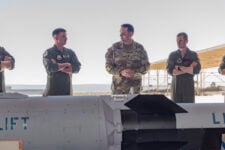The Air Force released the first public image of the HACM prototype, seen here at Edwards Air Force Base, California, in September 2023. (US Air Force photo by Lindsey Iniguez)
WASHINGTON — The Air Force is looking to move ahead with flight testing for its new hypersonic cruise missile in fiscal year 2025, according to a top service official and budget documents.
“We are working to mature HACM (Hypersonic Attack Cruise Missile) to critical design, along with other development activities to enable the flight test activities in fiscal year 2025,” Air Force Military Deputy for acquisitions Lt. Gen. Dale White testified to the House Armed Services Strategic Forces subcommittee on Tuesday.
HACM is an air-breathing, scramjet-powered cruise missile that can fly at speeds greater than Mach 5 and maneuver on the way to its target, making it harder for adversaries to shoot it down. The Air Force awarded RTX subsidiary Raytheon a contract for the weapon in 2022 with a scramjet to be supplied by Northrop Grumman. The HACM draws from previous work done with DARPA and continues a partnership with Australia. The service has previously said it wants to field the weapon by FY27.
According to FY25 budget documents released by the service Monday evening, a timeline for the HACM project shows “AUR [all-up-round] free flight testing” planned to begin in the first quarter and continue through the second quarter of FY25. All-up-round testing refers to trials of a fully assembled missile, and when the Air Force announced HACM’s contract award, the service said that the program will “us[e] Australian test infrastructure for the initial all-up-round flight tests.” The budget documents ask for about $517 million to continue the project in FY25 and project total R&D spending of roughly $2.4 billion through FY29.
An Air Force spokesperson additionally told Breaking Defense that “flight test activities” are included in the FY25 budget, but that “[e]xact details of program milestones and schedules cannot be released at this time.”
HACM is one of two hypersonic weapons under development by the Air Force. The other is the Air-Launched Rapid Response Weapon (ARRW) made by Lockheed Martin, which consists of a hypersonic glide vehicle mounted on a rocket.
Air Force Secretary Frank Kendall last year told lawmakers the service was “more committed” to HACM than ARRW, particularly considering that HACM is smaller and can be launched by more platforms than ARRW, whose size dictates it be launched by larger aircraft like bombers. The Air Force planning to integrate HACM on the F-15E and F/A-18F in FY25, budget documents say.
With a spotty test flight record already and one planned test left for ARRW, Air Force officials have said they will closely study the results to inform future hypersonic efforts. The service isn’t planning on procuring the weapon for now, though officials have suggested that could change in future budgets. Air Force officials originally had hoped to declare the weapon operational — the Pentagon’s first — as early as 2022.
The House hearing on Tuesday was convened so that lawmakers could receive updates on hypersonic efforts across the Pentagon, which are seen as key to counter advances made by Russia and China on the technology.
OPINION: To catch China and Russia in hypersonic race, US must embrace risk now
The Navy and Army are jointly working on a separate hypersonic weapon, though the project has been set back by delays. The Navy is additionally developing an air-launched hypersonic ship-killer dubbed the Hypersonic Air-Launched Offensive Anti-Surface (HALO) missile.
During the hearing, Jeffrey McCormick, senior intelligence analyst at the National Air and Space Intelligence Center, said that Russia has deployed hypersonic weapons in the war in Ukraine but noted China leads Russia “in support infrastructure and total inventory.” Both Moscow and Beijing are thought to be ahead of Washington in hypersonic weapon technology.
“China’s missile programs are comparable to top tier producers internationally, and China leads Russia with its hypersonic arsenal,” McCormick said.
The US is building out a new satellite network to better track adversary hypersonic weapons, as well as more advanced interceptors to knock them down.











